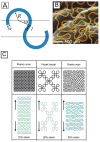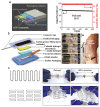Flexible and Stretchable Bioelectronics
- PMID: 35268893
- PMCID: PMC8911085
- DOI: 10.3390/ma15051664
Flexible and Stretchable Bioelectronics
Abstract
Medical science technology has improved tremendously over the decades with the invention of robotic surgery, gene editing, immune therapy, etc. However, scientists are now recognizing the significance of 'biological circuits' i.e., bodily innate electrical systems for the healthy functioning of the body or for any disease conditions. Therefore, the current trend in the medical field is to understand the role of these biological circuits and exploit their advantages for therapeutic purposes. Bioelectronics, devised with these aims, work by resetting, stimulating, or blocking the electrical pathways. Bioelectronics are also used to monitor the biological cues to assess the homeostasis of the body. In a way, they bridge the gap between drug-based interventions and medical devices. With this in mind, scientists are now working towards developing flexible and stretchable miniaturized bioelectronics that can easily conform to the tissue topology, are non-toxic, elicit no immune reaction, and address the issues that drugs are unable to solve. Since the bioelectronic devices that come in contact with the body or body organs need to establish an unobstructed interface with the respective site, it is crucial that those bioelectronics are not only flexible but also stretchable for constant monitoring of the biological signals. Understanding the challenges of fabricating soft stretchable devices, we review several flexible and stretchable materials used as substrate, stretchable electrical conduits and encapsulation, design modifications for stretchability, fabrication techniques, methods of signal transmission and monitoring, and the power sources for these stretchable bioelectronics. Ultimately, these bioelectronic devices can be used for wide range of applications from skin bioelectronics and biosensing devices, to neural implants for diagnostic or therapeutic purposes.
Keywords: conductive polymers; fabrication of stretchable bioelectronics; flexible and stretchable bioelectronics; flexible and stretchable power sources; stretchable batteries; stretchable polymer; stretchable sensors; supercapacitors.
Conflict of interest statement
The authors declare no conflict of interest.
Figures













References
-
- Yao G., Yin C., Wang Q., Zhang T., Chen S., Lu C., Zhao K., Xu W., Pan T., Gao M., et al. Flexible bioelectronics for physiological signals sensing and disease treatment. J. Mater. 2020;6:397–413. doi: 10.1016/j.jmat.2019.12.005. - DOI
Publication types
LinkOut - more resources
Full Text Sources
Miscellaneous

